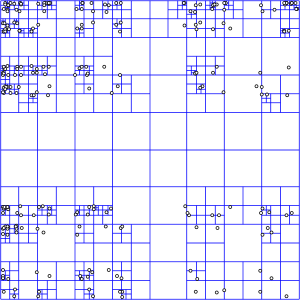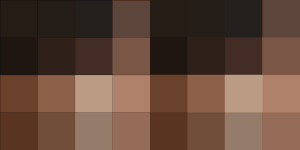This article has an unclear citation style. (April 2015) |
| Quadtree | ||||||||||||
|---|---|---|---|---|---|---|---|---|---|---|---|---|
| Type | Tree | |||||||||||
| Invented | 1974 | |||||||||||
| Invented by | Raphael Finkel and J.L. Bentley | |||||||||||
| ||||||||||||


A quadtree is a tree data structure in which each internal node has exactly four children. Quadtrees are the two-dimensional analog of octrees and are most often used to partition a two-dimensional space by recursively subdividing it into four quadrants or regions. The data associated with a leaf cell varies by application, but the leaf cell represents a "unit of interesting spatial information".
The subdivided regions may be square or rectangular, or may have arbitrary shapes. This data structure was named a quadtree by Raphael Finkel and J.L. Bentley in 1974.[1] A similar partitioning is also known as a Q-tree.
All forms of quadtrees share some common features:
- They decompose space into adaptable cells.
- Each cell (or bucket) has a maximum capacity. When maximum capacity is reached, the bucket splits.
- The tree directory follows the spatial decomposition of the quadtree.
A tree-pyramid (T-pyramid) is a "complete" tree; every node of the T-pyramid has four child nodes except leaf nodes; all leaves are on the same level, the level that corresponds to individual pixels in the image. The data in a tree-pyramid can be stored compactly in an array as an implicit data structure similar to the way a complete binary tree can be stored compactly in an array.[2]
- ^ Finkel, R. A.; Bentley, J. L. (1974). "Quad trees a data structure for retrieval on composite keys". Acta Informatica. 4 (1): 1–9. doi:10.1007/BF00288933. S2CID 33019699. Retrieved 6 November 2019.
- ^ Milan Sonka, Vaclav Hlavac, Roger Boyle. "Image Processing, Analysis, and Machine Vision". 2014. p. 108-109.